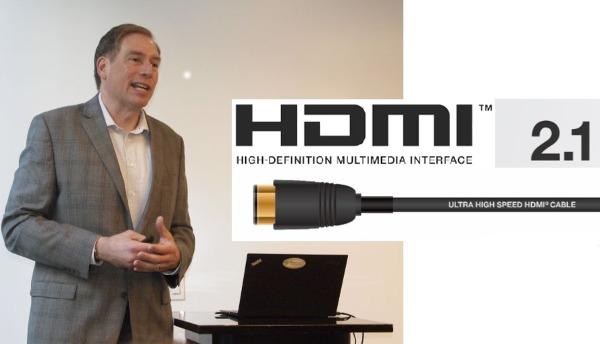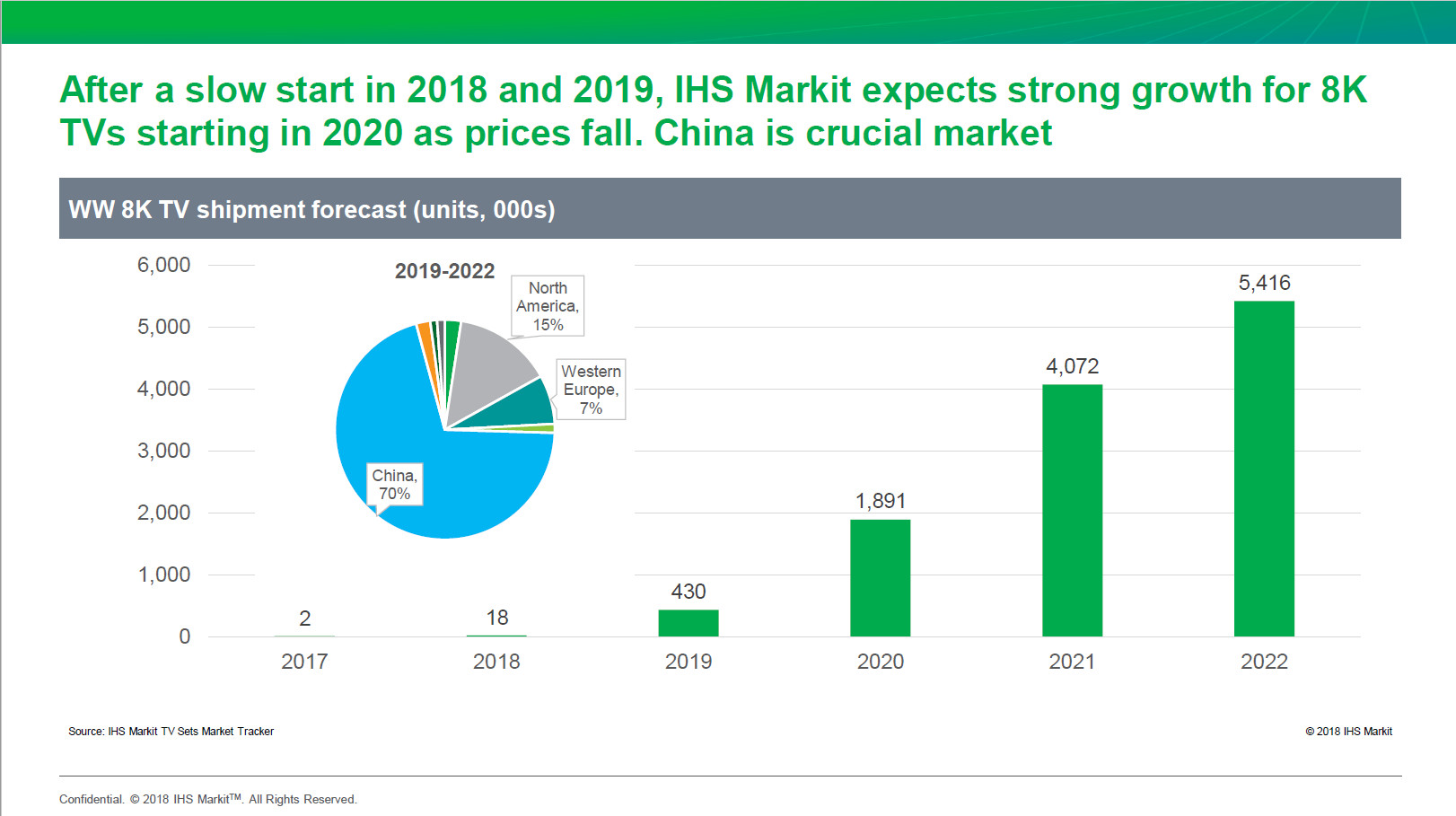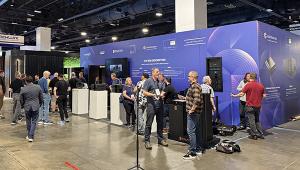I currently have a Marantz SR7007 at home (with only HDMI 1.4, no 4k!) and a Samsung UN65KS8000. I will be waiting for HDMI 2.1 to become a reality before I upgrade either. No point in buying anything over a couple hundred dollars that will have to be replaced in just a couple years. I was TEMPTED to buy the Marantz AV8005, since it's upgradable to HDMI 2.1, but it's a bit overkill for me. Will patiently wait for a SR8015 or SR7015, and whatever replaces Samsung's Q9FN.
HDMI 2.1 Features Start Trickling into AV Gear

Enhanced audio return channel (eARC), a key HDMI 2.1 feature that supports high-bandwidth audio formats, has begun rolling out in select 4K TVs, AV receivers, and soundbars as a firmware update, but the HDMI 2.1 feature supporting high-bandwidth video formats such as native 8K won’t appear in TVs and audio products until late 2019 or 2020, says the organization that licenses HDMI technology.
Rob Tobias, president/CEO of the HDMI Licensing Administrator (HDMI LA), sketched out the timetable for Sound & Vision following a New York City event organized by the group to update the press on the progress of HDMI 2.1 and 8K TV.
HDMI 2.1’s eARC feature widens the bandwidth of a TV’s audio return channel (ARC) to 38Mbps from 1Mbps, leaving ample room for bandwidth-intensive audio formats to pass from TV-connected 4K sources and smart-TV streaming apps to eARC-equipped AV receivers and soundbars. The eARC feature supports eight-channel 192kHz/24-bit PCM as well as Dolby TrueHD and DTS HD Master Audio mated with immersive Dolby Atmos and DTS:X metadata.
For video, HDMI 2.1 supports a range of video resolutions and refresh rates higher than what’s supported by HDMI 2.0, including 4K/120fps with 12-bit color depth, 8K/60fps, and 10K resolution up to 120fps.
The eARC firmware updates have begun appearing because specifications for eARC certification tests were finalized in August. Denon, Integra, Marantz, Onkyo, and Pioneer recently issued eARC firmware updates for select AVRs and Sony has done the same for some of its TVs, AVRs, and soundbars, the companies said. Yamaha, Bose, and Bluesound also plan eARC updates to existing products, the HDMI LA said.
More Tests to Come
The development of testing specs for other key HDMI 2.1 features, however, is still underway, including fixed rate link (FRL) signaling, which is required to achieve bandwidths up to 48Gbps to deliver resolutions above 4K/60fps, including 5K, 8K, and 10K.
In addition, because semiconductors supporting high-bandwidth video won’t proliferate until sometime in 2019, only a “small number” of TVs supporting HDMI 2.1 video bandwidths will be available in 2019, according to Tobias.
Test specs are also being written for 48Gbps HDMI cables and dynamic-metadata HDR technologies. HDMI 2.1 will add standardized support for dynamic HDR technologies even though the Dolby Vision and HDR10+ dynamic-metadata technologies have been implemented in proprietary ways in some HDMI 2.0 products, Tobias said. If such dynamic-metadata technologies are implemented through the HDMI 2.1 standard, however, interoperability problems are less likely to occur between products from different manufacturers, he added.
Gaming Features on the Way
Like eARC, gaming-related features “will be adopted more quickly” than other HDMI 2.1 features, Tobias said. Starting at January’s CES, he said, products will be announced with HDMI 2.1-certified gaming-related features such as variable refresh rate (VRR), quick frame transport (QFT), and auto low latency mode (ALLM) to reduce or eliminate lag time and otherwise enhance game play on TVs.
Microsoft has already downloaded firmware upgrades to add VRR and ALLM to the Xbox One, as has Samsung to some of its TVs, but the features haven’t yet been officially certified as HDMI 2.1-compliant.
The 8K TV Conundrum
Although a smattering of 8K TVs have already shipped around the world without 8K-capable HDMI 2.1 inputs, executives at Thursday’s event claimed consumers don’t necessarily have to wait for HDMI 2.1 to buy an 8K TV today. For one thing, today’s 8K TVs won’t necessarily become obsolete in the coming years, said Paul Gagnon, IHS Markit’s executive director of research and technology. The latest 8K TVs from Samsung and Sharp, for example, are two-piece solutions with an outboard HDMI-switching box that could potentially be swapped out for a box supporting HDMI 2.1. At least one company in the past offered TVs with “back packs” that could be swapped out to add higher performance technologies, he added.
Even if a modular upgrade doesn’t become available for a particular 8K TV model, Gagnon noted, upscaling technology has improved dramatically over the years to upscale today’s non-8K content to 8K resolution. Content from 8K cameras could also be displayed on 8K TVs, he noted. And a small selection of 8K videos are also available on YouTube, Tobias added.
In the future, Gagnon expects native 8K content to become more widely available. It took about two to three years after the introduction of 4K TVs for 4K content to become available, he noted. TV makers are ahead of the content industry in 8K adoption, he explained, because it is easier for them to make the transition and because they are eager to introduce technology that boosts average selling prices and profits.

Despite limited 8K content, Gagnon forecasts strong global 8K TV sales starting in 2020 as prices begin to fall. Global sales will rise from 430,000 in 2019 to 1.89 million in 2020, 4.07 million in 2021, and 5.4 million in 2022, with China accounting for 70% of sales during that time because of that country’s early-adopter proclivities and lower manufacturing costs. Consumer interest in big-screen TVs will help stoke demand for 8K displays to reduce pixel visibility when viewers sit close to a TV, he said.
The Future of AVRs in an eARC World
As for the future of AVRs as video-source switching centers when eARC-equipped TVs proliferate, Tobias told Sound & Vision that he foresees a continuing need for video-switching AVRs in home theaters. Theoretically, TVs equipped with multiple HDMI 2.1 inputs and eARC could pass through the widest bandwidth, highest resolution audio formats from connected video sources to an AVR’s eARC port, making it unnecessary to include video switching in an AVR. Nonetheless, Tobias said a video-switching AVR makes cosmetic and installation sense as a companion to a wall-mounted TV because it reduces the number of HDMI cables running to the TV from several to only one.
The development of HDMI 2.1 test specs appears to be behind what an executive with the HDMI Forum, which develops HDMI specs, told Sound & Vision last January at CES 2018. The executive said initial test specifications might be published in the second quarter of 2018 with the rest rolling out in phases through the third or fourth quarters.
Related:
- Log in or register to post comments


HDMI 2.1 should be here by next year. The problem is the year after that we'll start seeing ATSC 3.0 so we'll need new televisions too, lol.

You can always add an external tuner...but you usually can't upgrade your HDMI ports (Samsung sets with "OneConnect" boxes being the exception)

Does anyone else feel peeved when the AV receiver you paid $2,000 for becomes obsolete in 2 years or less because the HDMI standard changed?
I love the reduction in the number of cables you need, but the fact that AVRs can't be upgraded to pass through new video standards really cheeses me off and makes me less likely to spend big bucks on an AVR in the future.

I am "cheesed" too...my "flagship" Marantz AVR still sounds great...but doesnt have support for Atmos, nor support for HDMI 2.0/HDCP 2.2. Progress? I will still buy a higher end AVR...you really DO get what you pay for! But I am putting off a purchase until I can be reasonably sure that it will last 5+ years.

Don't even get me started on HDMI. We are literally on the 12th iteration of the HDMI 'standard' and the landfill is a graveyard of electronics thanks to this planned obsolescence.
The concept was great, the implementation was terrible. I can't tell you how many times I've bought AVR's/TV's/BluRay devices that ended up missing major features because an HDMI standard was changed a year or 2 after I bought them.
Want DVD audio, oh that's too bad you need HDMI 1.1
Want Dolby True HD/DTS-HD Master Audio? Oh sell your AVR and get HDMI 1.3
Interested in 3D? Better sell your one year old equipment and get HDMI 1.4
The latest fiasco is my Yamaha RX-A850 receiver. When I bought it I made sure it had HDMI 2.0 since I knew that meant 4K and HDR support even though I was still using an older 1080P LCD. A couple years later I buy the LG C7 OLED and guess what, my receiver does not support Dolby Vision...

How is it that supported 10K frame rates (120fps) will exceed 8K frame rates (60fps), as stated in this column? On the whole, the word "standard" should not be used with an ever-changing HDMI spec that never seems to settle. Like most, I'm waiting.





















































